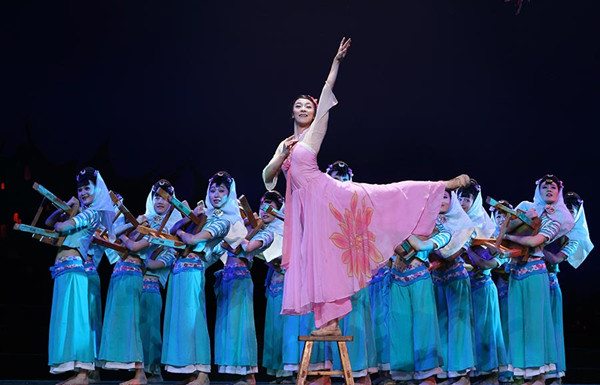
The show Dream of the Maritime Silk Road features a dancer during its Fujian performance on Aug 30. (Photo by Hu Meidong/China Daily)
A dance drama, which puts the ancient Maritime Silk Road in focus, was staged in Fuzhou, the capital of Fujian province, on Aug 30.
The show, titled Dream of the Maritime Silk Road, featured Chinese classical dance moves and was performed by the Fujian Opera and Dance Drama Theater.
It tells the story of a commercial fleet in China's Quanzhou port in Fujian province.
The captain of the fleet, A Hai, is invited by a Persian prince to help jointly develop a new sailing route.
During the voyage, the fleet is struck by a storm and the captain sacrifices his life to save the Persian prince.
The wife of the captain, Tong Hua, then raises their son alone and 20 years later, the son, Xiao Hai, follows his father to become a captain, keeping alive the family tradition.
Since the dance drama debuted in 2014, it has been performed more than 60 times, not just at home but also abroad, including at the United Nations headquarters in New York in February 2015.
According to the show's director, Xing Shimiao, the ancient Silk Road usually conjures up images of wind, deserts and camels. But when it comes to the Maritime Silk Road, it is a different story.
The Maritime Silk Road, which ran from China through Southeast Asia and the Indian Ocean to Europe, took shape about the time of the Qin Dynasty (221-206 BC) and reached its peak during the Song (960-1279) and Yuan (1271-1368) dynasties.
The route, once used by legendary travelers such as Marco Polo and the Moroccan explorer Ibn Battuta, originated in Quanzhou, which was where different cultures met, and which served as an international port.
Quanzhou was then known for its local Minnan culture (southern Fujian), artificial flowers, white chinaware, Oolong tea and folk music.
Speaking about the show's recent performance, Xing, the show's director, says: "We have added more local cultural elements into the production. For example, the Xunpu women, whose costumes derived from ocean culture, are an important part of the folk costumes in southern Fujian."
The latest production also blends music from a Western symphony orchestra and folk instruments from Fujian.
Xing adds that the show is also a symbol of the East-West commercial and cultural exchanges, echoing the 21st Century Maritime Silk Road, which marks the revival of the ancient trade route under Chinese President Xi Jinping's One Belt, One Road Initiative.
The plan of turning the dance drama into a movie, with 2-D and 3-D versions, was announced in Fuzhou late last month.


















































